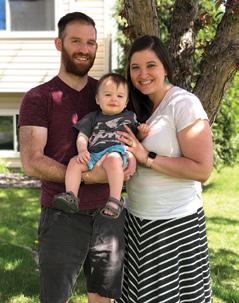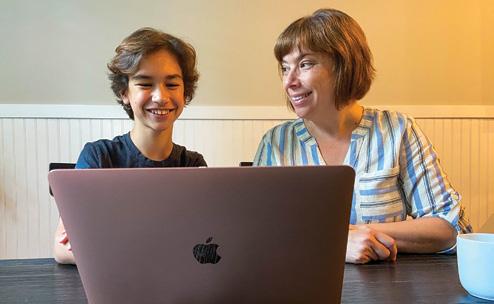
5 minute read
Far from home Broadband connects families across the globe
Story by KALEIGH COX
For Joshua and Kate Baker of Minnesota, welcoming their first child in 2019 was a time of joyful celebration and anticipation. Joshua Baker’s parents, however, weren’t close enough to celebrate in person, as they still live in his hometown over 1,000 miles away in New York.
Fortunately, the Bakers had broadband internet, so when they found out they would be parents, they turned to FaceTime to share their news. “With FaceTime, you get to see their emotion,” Kate Baker says. “They were very excited!”
The Bakers are not alone. With the arrival of fast, reliable broadband, people aren’t just connecting to the internet. They’re connecting to one another. When families find themselves spread across the globe, the ability to connect instantly is a particularly special gift.
When their son, Micah, was born, the Bakers continued to use online apps and tools to keep his grandparents involved in his life. Planning a trip to meet in person would take significant time, money and coordinated effort. But the internet makes it easy to spontaneously pop on and connect anytime, just as two families living in the same town might do.
The Bakers also invited his parents to join Cluster, a social media app that enables users to share photos, videos and other updates with a small, private group of family and friends.

Joshua and Kate Baker use broadband to keep in touch with distant family.
Joshua Baker’s mom, Faith Baker, was delighted. “We love to be as connected as we can,” she says. “I can struggle with the separation and feel that we miss so much. I appreciate how they’ve found ways to overcome that.”
Even 10-month-old Micah seems to appreciate the technology. “He recognizes his grandparents and understands who they are,” Kate Baker says.
She says being a new mom is busy, but staying connected online is worth the time and effort. “We’ll send pictures and keep communicating that way. It makes his grandparents feel included,” she says.
STAYING CONNECTED
For Jess and Sarah Curry in Texas, broadband wasn’t available in their early days of starting a family. As a military family navigating deployments, it was hard to stay connected. Jess Curry has left on deployment nine times over the past 20 years, and during those times, he would have to wait in line for an opportunity to check his email every few days. Even when videoconferencing technology became available, the inability to use it at home complicated things.
“We’d get all dressed up and drive to post to do a scheduled 15-minute video call,” Sarah Curry says. “There was so much pressure, and it seemed the kids would inevitably be melting down during the call. I would drive away feeling like I was supposed to be grateful, but I was miserable knowing my kids had cried through the call — and that seeing their dad for just a few minutes would only make them cry more.”
Thanks to advances in technology and a stronger internet connection, the most recent deployment was nothing like those early years. “He has Wi-Fi in his room and office, so we can talk on FaceTime every few days,” Sarah Curry says. “In between calls, the kids love using Marco Polo to record and send video messages for their dad to watch and reply to when he can. Before, it was hard for the kids to be put on the spot and think of all the things they needed to say to him. Now, they can send what they want to say when they think about it. Especially for my teenagers — that’s been really helpful.”
With the steady communication, each kid’s relationship with their dad feels more natural and ongoing, even during deployment. He’s more present for the little moments, like when their 15-yearold daughter’s dance class tried to teach a parent to dance.
“We called up Dad and used the screen on the computer,” says Sarah Curry. “She taught him this dance, and they did it together on a split screen. He was in his uniform doing plies and other ballet moves. He’s going to do what it takes to connect with his daughter, even if it means he has to pirouette in his room.”
OPEN COMMUNICATION
In many families, the internet allows children to connect with people they may never have met otherwise. When Linda Martin of North Carolina adopted her son Max in 2008, people around her discouraged her from pursuing an open adoption.
“We wanted him to be able to ask questions and learn about his family history, but we had a lot of pushback,” Martin says. “People said that birth parents move on and lose interest.”
Thankfully, that hasn’t happened, she says, and connecting online has helped. When Max was an infant, Martin shared photos and updates over email. As he grew, he began to pursue his own relationship with his birth mom, starting with phone calls with Martin present. Now, at 11 years old, Max likes using online apps to stay connected.
“We text a lot, and we use Instagram’s video call feature to talk face to face. I tell her everything, and I like to hear what’s going on in her life, too,” Max says. He shares pictures of his cat, gives updates when he loses a tooth and even made an excited video call when he landed the role of the Nutcracker in his ballet company’s production. He also gets to learn about his birth mom’s life. “She told me she went to Coachella the day after she found out she was pregnant with me,” he says. “So, technically, I can say I’ve been to Coachella.”
While Martin acknowledges that an open adoption isn’t right for everyone, she’s thankful for the ways her son has been able to know his birth mom. They met in person for his birthday last year, and the foundation of connecting online helped Max overcome any hesitations and enjoy the meeting. “It was really fun!” he says.
They hope to meet again when he turns 13, but in the meantime, he’s thankful for opportunities to share his life with her online. “We talk a lot now, and I get to tell her everything,” Max says.

After adopting Max, left, Linda Martin of North Carolina used broadband to help him stay in touch with his birth mother.

When Jess Curry was on deployment with the U.S. Army, broadband helped his family stay in touch.


